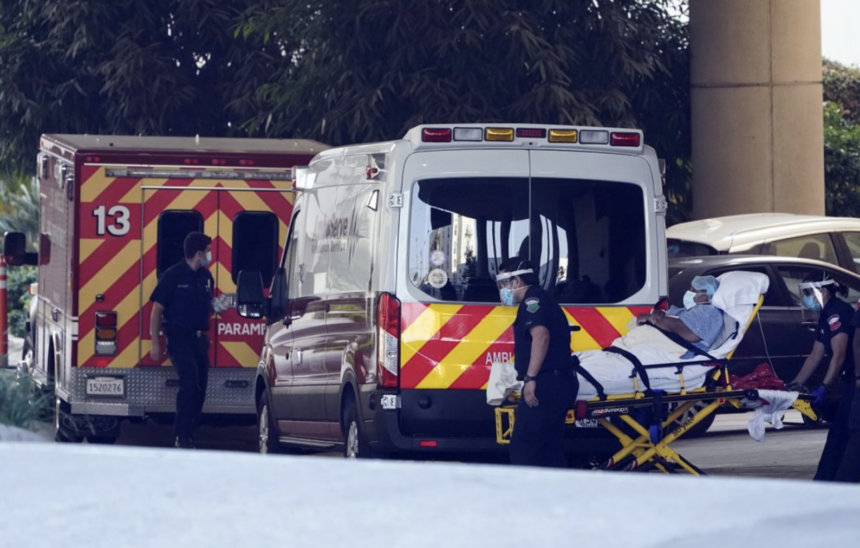California hospital, in midst of COVID-19 crisis, maxes out

LOS ANGELES (AP) — The crush of patients with coronavirus is so severe in Los Angeles that on Tuesday they exceeded the normal capacity at Martin Luther King Jr. Community Hospital, which serves many Blacks and Latinos in America’s largest county.
The hospital in the south part of the city, which has a capacity of 131 patients, was treating 215 patients, 135 of them with COVID-19, said Jeff Stout, the interim chief nursing and operating officer.
MLK is emblematic of what is happening at hospitals in Los Angeles, where a surge of coronavirus cases has overwhelmed medical staff, created a shortage of oxygen and led to a directive to ambulance crews to stop transporting patients they can’t revive in the field.
Stout said the hospital was finalizing its crisis standards of care, which are guidelines for rationing treatment when staff, medicine and equipment are in short supply.
“We’re not there yet,” Stout said. “Every day, every hour we’re trying to avoid going into crisis care. The ultimate goal with crisis care is never to get there.”
For much of the year, the nation’s most populous state did the right things to avoid a catastrophe. But now the virus is raging and California remains at or near the top of the list of states with the most new cases per capita. Even with vaccines now being administered, albeit slowly, it is expected to take many more weeks to quell the contagion.
LA is the epicenter of California’s surge that is expected to get worse in coming weeks when another spike is expected after people traveled or gathered for Christmas and New Year’s. Much of the state is under a stay-home order and open businesses are operating with limited capacity.
Los Angeles continues to see hospitalizations rise day after day, setting a new record Tuesday with almost 8,000 hospitalized and more than a fifth of those in intensive care units. The county, which accounts for a quarter of California’s 40 million residents, has more than 40% of the state’s 27,000 coronavirus deaths.
The San Joaquin Valley and Southern California regions have been hardest hit, with no more capacity in ICUs to treat COVID-19 patients.
On Tuesday, California issued a public health order requiring hospitals in Los Angeles and 13 other counties in those regions to delay nonessential “and non-life threatening” surgeries in order to provide beds. The order, which will last at least three weeks, will also apply to any county where ICU capacity to treat COVID-19 patients is bottoming out. The order also requires hospitals statewide to accept patients from other medical facilities that have implemented contingency procedures because they are filling up.
Fresno County’s top doctor says he’s watching what’s happening in LA County very closely as he prepares for a seemingly inevitable new surge from the holidays.
“I’m very worried that we are going to see an uptick in the number of hospitalizations and deaths,” said Dr. Rais Vohra, interim Fresno health officer.
Hospitals in Los Angeles County have had to declare an “internal disaster” and close their doors at times because they’ve become so overwhelmed, leaving ambulances waiting up to eight hours and diverting others to different emergency rooms.
Ambulance crews in Los Angeles County on Monday were directed to stop transporting patients they can’t resuscitate in the field.
Dr. Marc Eckstein, medical director and emergency medical services commander of the LA Fire Department, said the directive recognizes that such scenarios are “all risk and no gain” at this time. He said crews transporting someone without a pulse give families false hope, take the ambulance out of service, expose the workers to COVID-19 and require decontaminating the vehicle.
“To be clear, we’re not asking first responders to decide who lives and who dies,” Eckstein said. “These are people who are clinically dead.”
In a separate memo, the county also told ambulance crews not to provide supplemental oxygen to patients whose oxygen saturation levels drop below 90%.
Oxygen is in short supply due to the demands of patients struggling to breathe. Eckstein said patients with COVID-19 pneumonia are using up to 60 liters of oxygen a minute, which is at least 10 times more than a typical pneumonia patient would need.
Some older hospitals in Southern California had outdated systems that can’t handle the flow of oxygen, and the state contracted with the Army Corps of Engineers to upgrade them.
At Martin Luther King Jr. Community Hospital, a large number of patients not being held in traditional rooms required bottled oxygen, which is in short supply, Stout said.
MLK has had to house patients in its former gift shop, a chapel, tents and hallways. The emergency department had 45 to 50 patients waiting for beds in the hospital Tuesday.
The hospital has a 10-bed ICU but has expanded that level of care to three sections of the hospital and is treating 36 patients.
It’s biggest problem isn’t a lack of space, but a staff shortage, mainly nurses and respiratory therapists, a common struggle for hospitals that are competing for any additional workers.
The state Office of Emergency Services on Tuesday requested 500 additional federal medical workers to help after learning that the USNS Mercy Hospital ship, which docked off Los Angeles earlier in the year for overflow patients, was in dry dock and would not be returning.
Stout said he’s not thinking past tomorrow when it comes to the crisis.
“We’re taking it one hour at a time, one patient at a time,” he said.